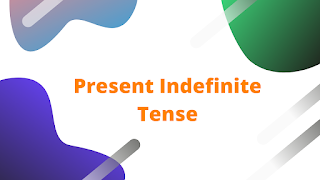Present Indefinite Tense Examples & Structure
- The verb and its conjugation.
- Identifying the subject/person.
- Use of Auxiliary/Helping Verbs.
THE VERB AND ITS CONJUGATION:
A verb is a word that denotes:
- Actions: go, do, play, buy, try, work, sleep......
- Feelings: feel, love, prefer, like, pity.....
- Existence/State: be- am, are, was, were, been.
- Possession: have, has, had.
Note: The verb is the most important word in a language, without it, no sentence can be made.
CONJUGATION: Using a verb in its different styles/forms with regard to time.
A verb has 4 principal styles/forms. The four principal forms are:
- The Base/Present Form/ Infinitive (V1)
- The Past Form (V2).
- The Past Participle (V3)
- The Present Participle ( V4).
From the conjugation point of view, all the verbs have been divided into two groups viz;
1. Regular/Easy/Weak Verbs: Those verbs whose past (V2) & Past Participle (V3) forms are obtained by adding "d/ed" to the present form.
EXAMPLE OF REGULAR VERBS:
- Work, Worked, Worked, Working.
- Play, Played, Played, Playing.
- End, Ended, Ended, Ending.
- Cast, Cast, Cast, Casting.
- Cut, Cut, Cut, Cutting.
2. Irregular/Hard/Strong Verbs: Those verbs whose Past V2 and V3 (Past Participle) forms are obtained at random ( without observing rules)
EXAMPLES OF IRREGULAR VERBS:
- See, Saw, Seen, Seeing.
- Go, Went, Gone, Going.
- Break, Broke, Broken, Breaking.
- Drink, Drank, Drunk, Drinking.
Conjugation of verbs denoting existence/state/possession.
V1 Present:
- Be= am-is-are.
- Have/Has
- Do/Does.
V2 Past:
- Was/were.
- Had.
- Did.
V3 Past Participle:
- Been
- Had
- Done
V4 Present Participle:
- Being.
- Having.
- Doing.
FUNDAMENTAL NO 2:
USE OF AUXILIARY/HELPING VERBS.
Many tenses take a smaller verb along with the principal form. That smaller verb used before the principal verb maintains the grammatical balance of the sentence.
Such a verb is called an auxiliary or a helping verb.
Following are the main Auxiliary Verbs Used in English:-
- Be:- are, was, were, been, being.
- Do- do, does, did.
- have/has/had.
- will/shall
- Can, could, may, might, should, ought to, must, have to, would dare, need, used to, will, shall.
Of the above, the first four groups are directly used with the tenses. They are therefore called the primary auxiliaries/general auxiliaries.
The fifth group of auxiliaries denotes situations like; ability, possibility, prediction, obligation, etc. They are therefore called Modal Auxiliary Verbs or simply Modals.
Note: The Aux. Verbs (be, do, have) play a double role in English. In the presence of a principal verb, they take the role of helping verb, and in the absence of a principal verb, they themselves become the principal verbs to denote existence, state, actions, or possession. The following examples make it clear.
This time yesterday, I was at the bus stop.
Here "was'' is showing the existence.
I was waiting for the bus.
Here was is an auxiliary verb and waiting a principal verb.
I had a problem, I had asked the teacher for help.
Here Had-1 is the Principal Verb, showing possession.
Had-2 is Auxiliary Verb.
And,
Asked is the principal verb.
FUNDAMENTAL NO 2
IDENTIFYING THE SUBJECT/PERSON.
Every action has got a fore behind it. It is that force which performs the actions directly or indirectly. The noun or Pronoun that reflects the action is called the subject or the person. All the nouns and pronouns in English play the role of subjects.
The following chart gives us the clarification of SUBJECTS in English.
Singular:
I (First Person), You (2nd Person) He/She/It/this/that/Tom/Son/Girl/Daughter/Principal/Honesty/World (3rd Person)
Plural:
We (First Person), You (2nd Person), They/These/Those/Men/Women/Mothers/Fathers/Policies (3rd Person)
USE OF TENSES
There are 3 main tenses, viz;
- The Present Tense.
- The Past Tense.
- The Future Tense.
On a smaller time scale, each of the three tenses has four Sub-Ordinate Kinds, viz;
- Simple Or Indefinite.
- Perfect Or Perfective.
- Perfect Continuous.
Now, Let's begin;
1. THE PRESENT TENSE
a. The Present Indefinite Tense:
Applications: This Tense is used to denote Actions which are true in general, such actions include:-
i) Our Daily Habits, Customs, And Traditions:-
EXAMPLE:
- I get up early and go for a walk.
- John tells so many lies.
- Kashmiris celebrate their marriages with great pomp and show.
ii) Universal Facts:-
EXAMPLE:
- The sun rises in the east and sets in the west.
- The moon is a natural satellite of the earth.
ii) Proverbs and Quotations:-
EXAMPLE:
- ''The Tree that bears more fruits gets more stones.''
- " Barking dog seldom bite."
- ''Frailty! thy the name is women" SHAKESPEARE
iv) Time-table & Programmes:-
EXAMPLE:
- Our examination begins in the last week of Oct. & concludes in the second week of Nov.
- The train for Washington leaves New York City at 12:30 A.M.
v) Instructions, Orders, Commands, Requests:-
Often without subject.
EXAMPLE:
- Walk slowly and look your way.
- Go to the chowk and get today's paper.
- Go fast and cordon the fort.
vi) Newspaper headlines:-
Govt announces summer vacations.
vii) Advice/Do not's/ Do's :-
EXAMPLE:
- Trust in God & do the right.
- Don't go near the river, it's dangerous.
- Do come regularly to School.
viii) Along with some fixed Structures:
EXAMPLE:
- I believe.
- I see.
- I think.
- I enclose.
- I doubt.
Present Indefinite Tense Structure:
Rule 1: Use the present (V1)/base form of the verb.
Rule 2: Don't use any auxiliary verb with positive sentences. However, add "s/es" to the principal verb if the subject is 3rd Person + Singular.
PRESENT INDEFINITE TENSE EXAMPLES :
- Alex is a terrific driver. He DRIVES (drive) usually at a hundred and DOES NOT OBEY traffic rules.
- Sally IS (be) very particular about her children. Every morning, she DRIVES (drive) herself to school.
- Usually, buses HALT (halt) at the bus stop.
- At home, we ARE (be) fruit growers. We GROW (grow) many kinds of apples but we DON'T GROW (not/grow) any plums.
- Excuse me, DO you SPEAK (speak) English?
- My sister IS a student of 12th. She GOES to a higher secondary school daily (go)
- The sun SHINES for six months in Norway (shine).
- Bad students DO NOT WORK hard (not/work)
- Babies CRY when they are hungry (cry)
- My brother PLAYS tennis occasionally.
- Haste MAKES waste (make).
- What DOES your father DO (do)?
- He is a teacher. He TEACHES (teach) at a college. He DOES NOT GO to any factory for work. (not/go).

